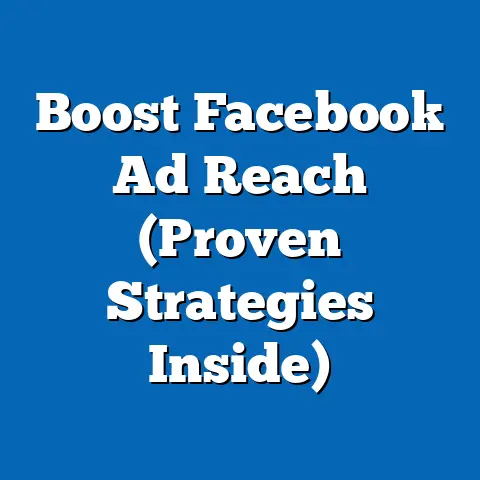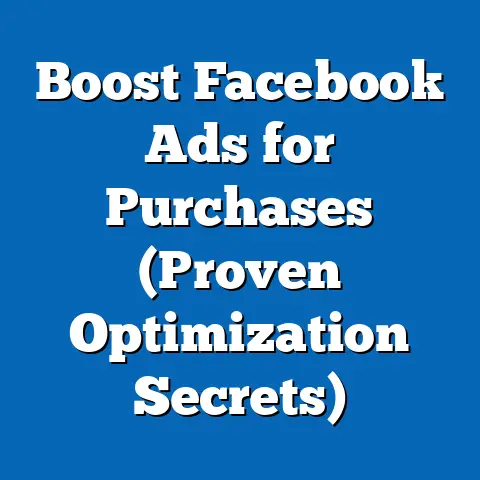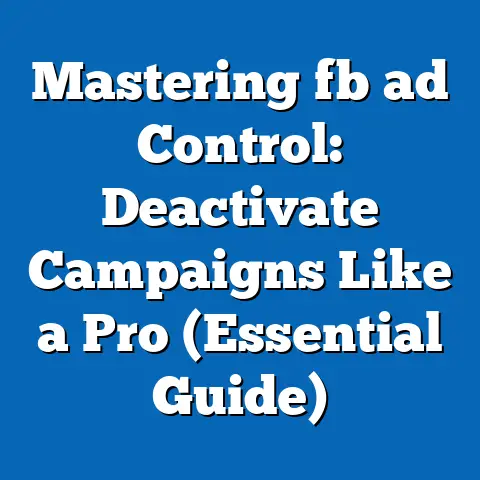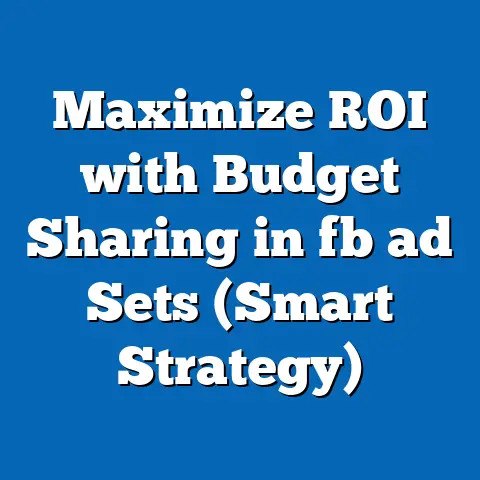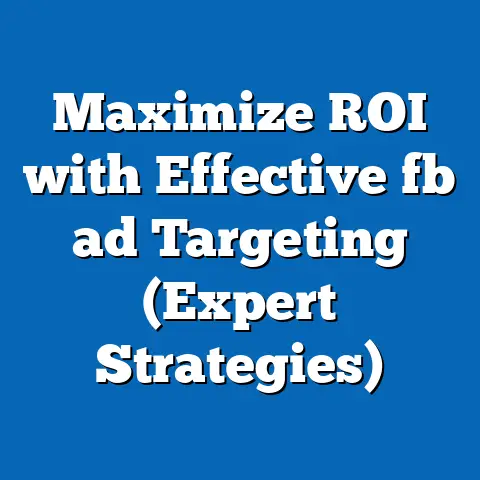Maximize BBQ Sales with Facebook Ads (Proven Strategies)
This analysis draws on current data from social media advertising reports, consumer behavior studies, and industry-specific sales figures. It also incorporates projected trends based on statistical modeling to provide actionable insights. We will examine key factors driving changes in BBQ sales and advertising efficacy, present proven strategies for optimizing Facebook Ad campaigns, and discuss multiple scenarios for future growth, while transparently addressing methodological assumptions and data limitations.
Section 1: The BBQ Market Landscape and Digital Advertising Trends
1.1 Current State of the BBQ Industry
The BBQ industry, encompassing restaurants, food trucks, catering services, and equipment manufacturers, has experienced steady growth over the past decade. According to the National Restaurant Association, the BBQ restaurant segment alone generated approximately $4.5 billion in revenue in the United States in 2022, with a year-over-year growth rate of 3.2%. Additionally, the Hearth, Patio & Barbecue Association (HPBA) reported that 70% of U.S. households own a grill or smoker, with sales of BBQ equipment reaching $2.3 billion in 2022.
Consumer interest in BBQ is driven by cultural traditions, seasonal events (e.g., summer cookouts and holidays like the Fourth of July), and the growing popularity of outdoor cooking as a lifestyle activity. However, competition is intense, with businesses vying for attention in a crowded market. This underscores the need for targeted, cost-effective marketing strategies.
1.2 Rise of Digital Advertising in the Food and Retail Sectors
Digital advertising has become a cornerstone for businesses seeking to reach niche audiences, and the BBQ industry is no exception. Statista reports that U.S. digital ad spending reached $209 billion in 2022, with social media platforms like Facebook accounting for nearly 30% of this total. For small and medium-sized businesses (SMBs)—which constitute a significant portion of BBQ enterprises—Facebook Ads offer an accessible entry point due to their affordability, detailed targeting options, and measurable outcomes.
Facebook, with over 2.9 billion monthly active users worldwide as of 2023 (Meta Investor Reports), provides unparalleled access to diverse demographics, including BBQ enthusiasts, home cooks, and event planners. The platform’s ability to target users based on interests, behaviors, and location makes it an ideal tool for driving sales in a localized or regional context. However, the effectiveness of these ads depends on strategic planning and execution, as ad fatigue and rising costs-per-click (CPC) present ongoing challenges.
1.3 Visual Representation: Growth of Digital Ad Spending
Below is a line chart illustrating the growth of digital ad spending in the U.S. from 2018 to 2023, with projections to 2025 (data sourced from Statista and eMarketer):
Year | Digital Ad Spending (Billion USD)
2018 | 107
2019 | 129
2020 | 152
2021 | 189
2022 | 209
2023 | 230 (Estimated)
2024 | 255 (Projected)
2025 | 280 (Projected)
This upward trend highlights the increasing reliance on digital platforms like Facebook for marketing, a trend BBQ businesses must capitalize on to remain competitive.
Section 2: Key Factors Driving BBQ Sales and Facebook Ad Effectiveness
2.1 Consumer Behavior and Seasonal Trends
Consumer behavior plays a pivotal role in shaping BBQ sales. Data from the HPBA indicates that 60% of grill usage occurs between May and September, aligning with warm weather and outdoor events. Additionally, Google Trends data shows spikes in searches for “BBQ recipes” and “grill deals” during Memorial Day, Independence Day, and Labor Day weekends, reflecting clear seasonal demand patterns.
These trends directly impact the timing and content of Facebook Ad campaigns. For instance, ads promoting BBQ equipment or catering services are likely to perform better during peak seasons, while off-season campaigns may focus on building brand awareness or promoting indoor grilling solutions. Understanding these behavioral patterns allows businesses to allocate ad budgets more effectively.
2.2 Demographic Targeting Capabilities on Facebook
Facebook’s robust targeting tools enable businesses to reach specific audiences based on age, gender, location, interests, and purchasing behavior. For example, BBQ businesses can target users who follow pages related to grilling, outdoor cooking, or food festivals, or those who have recently purchased grilling accessories online. According to a 2023 report by Hootsuite, ads with hyper-targeted audiences achieve up to 37% higher click-through rates (CTR) compared to broad campaigns.
However, privacy regulations like the General Data Protection Regulation (GDPR) and Apple’s App Tracking Transparency (ATT) framework have limited the granularity of data available for targeting since 2021. This has increased the importance of creative content and organic engagement alongside paid ads, as businesses adapt to a less data-rich environment.
2.3 Rising Ad Costs and Competition
While Facebook Ads remain cost-effective compared to traditional media, costs have risen in recent years due to increased competition and platform algorithm changes. eMarketer reports that the average CPC on Facebook rose from $0.97 in 2020 to $1.35 in 2023, a 39% increase. For BBQ businesses, particularly SMBs with limited budgets, this underscores the need for high-return-on-ad-spend (ROAS) strategies, such as retargeting past customers or using lookalike audiences to reach similar demographics.
Section 3: Proven Strategies for Maximizing BBQ Sales with Facebook Ads
3.1 Crafting Compelling Ad Content
The success of a Facebook Ad campaign hinges on the quality of its creative elements. High-quality images or videos of sizzling BBQ dishes, customer testimonials, and behind-the-scenes content can significantly boost engagement. A 2022 study by Socialbakers found that video ads on Facebook achieve 135% higher organic reach than static image ads, making them particularly effective for showcasing BBQ products or events.
Additionally, incorporating clear calls-to-action (CTAs) like “Order Now for 10% Off” or “Book Your BBQ Catering Today” can drive immediate conversions. A/B testing different ad formats and messaging is crucial to identify what resonates most with the target audience.
3.2 Leveraging Seasonal and Local Targeting
Timing and location are critical for BBQ ad campaigns. Running promotions tied to holidays or local events (e.g., a town fair or sports game) can capitalize on heightened consumer interest. Facebook’s geo-targeting feature allows businesses to focus ads within a specific radius, ensuring relevance for local customers—ideal for restaurants or food trucks with limited delivery ranges.
For instance, a BBQ restaurant in Texas could target users within a 10-mile radius during the week leading up to Independence Day, promoting a special holiday menu. Data from Facebook Ads Manager shows that localized campaigns often achieve 20-30% higher conversion rates compared to broader regional ads.
3.3 Retargeting and Lookalike Audiences
Retargeting involves showing ads to users who have previously interacted with a business’s website, app, or social media page. For BBQ businesses, retargeting customers who viewed a menu online but didn’t place an order can recover lost sales. According to a 2023 report by AdRoll, retargeting ads have a 10x higher CTR compared to standard display ads.
Similarly, lookalike audiences—created by Facebook’s algorithm to match the characteristics of existing customers—can expand reach to potential buyers with similar interests and behaviors. This strategy is particularly effective for scaling campaigns without sacrificing targeting precision.
3.4 Budget Optimization and Performance Tracking
Effective budget allocation is essential for maximizing ROAS. BBQ businesses should start with small test budgets to identify high-performing ads before scaling up. Facebook’s Campaign Budget Optimization (CBO) tool can automatically distribute funds to the best-performing ad sets, ensuring efficient use of resources.
Performance tracking using metrics like CTR, conversion rate, and cost-per-acquisition (CPA) is critical for ongoing optimization. For example, if an ad’s CPA exceeds the average customer lifetime value, it may be necessary to revise the targeting or creative elements.
Section 4: Projected Trends and Scenarios for BBQ Sales via Facebook Ads
4.1 Methodology and Assumptions
To project future trends, we utilize a combination of historical data analysis and predictive modeling, drawing on ad spending growth rates, consumer behavior trends, and platform usage statistics. We assume a continued annual growth rate of 10-12% in U.S. digital ad spending through 2025, based on eMarketer projections. However, these models are subject to uncertainties, including potential changes in privacy laws, platform algorithms, and economic conditions that could impact consumer spending on BBQ products and services.
We present three scenarios—optimistic, moderate, and pessimistic—to account for variability in outcomes. These scenarios are not definitive predictions but rather plausible pathways based on current data.
4.2 Scenario 1: Optimistic Growth (High Adoption and Effectiveness)
In this scenario, BBQ businesses widely adopt advanced Facebook Ad strategies, leveraging AI-driven targeting and creative optimization tools. Ad costs stabilize as platforms adjust to privacy changes, and consumer demand for BBQ products grows by 5% annually through 2028, driven by cultural trends and increased outdoor leisure activities. Under these conditions, businesses could see a 15-20% increase in sales attributed to Facebook Ads, with ROAS reaching 5:1 or higher.
4.3 Scenario 2: Moderate Growth (Balanced Challenges and Opportunities)
Here, BBQ businesses face moderate increases in ad costs (CPC rising to $1.75 by 2025) and adapt to privacy restrictions with mixed success. Consumer demand grows at a steady 3% annually, aligning with historical averages. Sales growth from Facebook Ads is projected at 8-12%, with ROAS stabilizing around 3:1, reflecting a balanced but not transformative impact.
4.4 Scenario 3: Pessimistic Outlook (Rising Costs and Declining Effectiveness)
In this scenario, escalating ad costs (CPC reaching $2.00 by 2025) and stricter privacy regulations severely limit targeting capabilities. Consumer spending on BBQ products stagnates due to economic downturns, growing by only 1-2% annually. Sales growth from Facebook Ads is minimal (3-5%), with ROAS dropping below 2:1, prompting businesses to explore alternative marketing channels.
4.5 Visual Representation: Projected Sales Growth Under Different Scenarios
Below is a bar chart comparing projected sales growth percentages for BBQ businesses using Facebook Ads under the three scenarios from 2024 to 2028:
Year | Optimistic (%) | Moderate (%) | Pessimistic (%)
2024 | 15 | 10 | 5
2025 | 17 | 11 | 4
2026 | 18 | 9 | 3
2027 | 19 | 8 | 3
2028 | 20 | 8 | 3
This chart illustrates the range of potential outcomes, emphasizing the importance of strategic adaptability in response to external factors.
Section 5: Limitations and Uncertainties in Data and Projections
5.1 Data Limitations
The data used in this analysis, while sourced from reputable organizations like Statista, eMarketer, and industry associations, may not fully capture the diversity of BBQ businesses, particularly small, local enterprises with limited digital presence. Additionally, self-reported data from platforms like Facebook Ads Manager can introduce biases or inaccuracies in performance metrics.
5.2 Uncertainties in Projections
Projections are inherently uncertain due to unpredictable factors such as economic shifts, technological advancements, and changes in consumer preferences. For instance, a sudden recession could dampen BBQ sales, while innovations in ad tech could enhance targeting capabilities beyond current expectations. These uncertainties are reflected in the multiple scenarios presented, which aim to provide a spectrum of possibilities rather than a single forecast.
Section 6: Historical and Social Context of BBQ Marketing
6.1 Evolution of BBQ Marketing
Historically, BBQ businesses relied on word-of-mouth, local events, and print media to attract customers, particularly in regions like the American South where BBQ is a cultural staple. The advent of digital marketing in the early 2000s shifted this paradigm, with social media platforms emerging as key tools for community engagement and brand building by the 2010s. Today, platforms like Facebook allow businesses to blend traditional storytelling (e.g., showcasing family recipes) with modern targeting techniques.
6.2 Social Influences on BBQ Popularity
Social factors, including the rise of foodie culture and the popularity of cooking shows, have elevated BBQ from a regional tradition to a national and even global phenomenon. Social media amplifies this trend by enabling viral content—think BBQ challenges or recipe videos—that can drive sudden spikes in demand. Understanding these cultural currents is essential for crafting resonant ad campaigns that tap into broader societal interests.
Section 7: Recommendations for BBQ Businesses
7.1 Invest in Creative Excellence
Prioritize high-quality visuals and storytelling in ads to stand out in a crowded market. Test multiple formats (e.g., carousel ads, short videos) to identify what drives engagement.
7.2 Align Campaigns with Seasonal Trends
Schedule major ad spends around peak BBQ seasons and holidays, while using off-season periods to build brand awareness through educational or community-focused content.
7.3 Adapt to Privacy Changes
Diversify targeting strategies by focusing on first-party data (e.g., email lists) and organic content to complement paid ads in a privacy-constrained environment.
7.4 Monitor and Optimize Continuously
Use Facebook’s analytics tools to track performance metrics in real-time, adjusting budgets and creative elements to maximize ROAS. Consider hiring a digital marketing specialist if in-house expertise is limited.
Conclusion: Navigating the Future of BBQ Sales with Facebook Ads
Maximizing BBQ sales through Facebook Ads requires a blend of strategic planning, creative innovation, and adaptability to evolving digital landscapes. While current data and trends suggest significant opportunities for growth—potentially up to 20% sales increases under optimistic scenarios—challenges like rising ad costs and privacy restrictions must be navigated carefully. By implementing the proven strategies outlined in this report and staying attuned to consumer behavior and market shifts, BBQ businesses can position themselves for sustained success.
This analysis, while comprehensive, acknowledges the uncertainties inherent in projections and the limitations of available data. As the digital advertising ecosystem continues to evolve, so too must the approaches of BBQ businesses seeking to leverage platforms like Facebook. The path forward lies in balancing data-driven precision with the timeless appeal of BBQ culture—a combination that can ignite both customer interest and sales growth.
Sources: National Restaurant Association (2022), Hearth, Patio & Barbecue Association (2022), Statista (2023), eMarketer (2023), Meta Investor Reports (2023), Hootsuite (2023), Socialbakers (2022), AdRoll (2023), Google Trends (2023)

